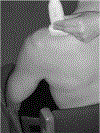Effects of age and pathology on shear wave speed of the human rotator cuff
- PMID: 28657192
- PMCID: PMC7050544
- DOI: 10.1002/jor.23641
Effects of age and pathology on shear wave speed of the human rotator cuff
Abstract
Rotator cuff tears are common and often repaired surgically, but post-operative repair tissue healing, and shoulder function can be unpredictable. Tear chronicity is believed to influence clinical outcomes, but conventional clinical approaches for assessing tear chronicity are subjective. Shear wave elastography (SWE) is a promising technique for assessing soft tissue via estimates of shear wave speed (SWS), but this technique has not been used extensively on the rotator cuff. Specifically, the effects of age and pathology on rotator cuff SWS are not well known. The objectives of this study were to assess the association between SWS and age in healthy, asymptomatic subjects, and to compare measures of SWS between patients with a rotator cuff tear and healthy, asymptomatic subjects. SWE images of the supraspinatus muscle and intramuscular tendon were acquired from 19 asymptomatic subjects and 11 patients with a rotator cuff tear. Images were acquired with the supraspinatus under passive and active (i.e., minimal activation) conditions. Mean SWS was positively associated with age in the supraspinatus muscle and tendon under passive and active conditions (p ≤ 0.049). Compared to asymptomatic subjects, patients had a lower mean SWS in their muscle and tendon under active conditions (p ≤ 0.024), but no differences were detected under passive conditions (p ≥ 0.783). These findings identify the influences of age and pathology on SWS in the rotator cuff. These preliminary findings are an important step toward evaluating the clinical utility of SWE for assessing rotator cuff pathology. © 2017 Orthopaedic Research Society. Published by Wiley Periodicals, Inc. J Orthop Res 36:282-288, 2018.
Keywords: muscle; pathology; rotator cuff; shear wave elastography; tendon.
© 2017 Orthopaedic Research Society. Published by Wiley Periodicals, Inc.
Figures





Similar articles
-
Supraspinatus Muscle and Tendon Stiffness Changes After Arthroscopic Rotator Cuff Repair: A Shear Wave Elastography Assessment.J Orthop Res. 2020 Jan;38(1):219-227. doi: 10.1002/jor.24469. Epub 2019 Sep 25. J Orthop Res. 2020. PMID: 31517408
-
Comparison of Passive Stiffness Changes in the Supraspinatus Muscle After Double-Row and Knotless Transosseous-Equivalent Rotator Cuff Repair Techniques: A Cadaveric Study.Arthroscopy. 2016 Oct;32(10):1973-1981. doi: 10.1016/j.arthro.2016.02.024. Epub 2016 May 4. Arthroscopy. 2016. PMID: 27157656 Free PMC article.
-
An evaluation of shear wave elastographic characteristics of the supraspinatus tendon after rotator cuff repair.J Shoulder Elbow Surg. 2023 Jun;32(6):e319-e327. doi: 10.1016/j.jse.2022.11.022. Epub 2023 Feb 3. J Shoulder Elbow Surg. 2023. PMID: 36740010
-
Utility of sonoelastography for the evaluation of rotator cuff tendon and pertinent disorders: a systematic review and meta-analysis.Eur Radiol. 2020 Dec;30(12):6663-6672. doi: 10.1007/s00330-020-07059-2. Epub 2020 Jul 14. Eur Radiol. 2020. PMID: 32666319
-
The application of shear wave elastography with ultrasound for rotator cuff tears: a systematic review.JSES Rev Rep Tech. 2023 Mar 31;3(3):336-342. doi: 10.1016/j.xrrt.2023.02.008. eCollection 2023 Aug. JSES Rev Rep Tech. 2023. PMID: 37588504 Free PMC article. Review.
Cited by
-
Ultrasound elastography: compression elastography and shear-wave elastography in the assessment of tendon injury.Insights Imaging. 2018 Oct;9(5):791-814. doi: 10.1007/s13244-018-0642-1. Epub 2018 Aug 17. Insights Imaging. 2018. PMID: 30120723 Free PMC article. Review.
-
Normative Data of Supraspinatus Muscle Shear Wave Elastography in Healthy Shoulders: A Cross-Sectional Study.J Clin Med. 2025 Feb 9;14(4):1121. doi: 10.3390/jcm14041121. J Clin Med. 2025. PMID: 40004651 Free PMC article.
-
Clinical utilization of shear wave elastography in the musculoskeletal system.Ultrasonography. 2019 Jan;38(1):2-12. doi: 10.14366/usg.18039. Epub 2018 Aug 23. Ultrasonography. 2019. PMID: 30343557 Free PMC article.
-
Presurgical tear characteristics and estimated shear modulus as predictors of repair integrity and shoulder function one year after rotator cuff repair.JSES Int. 2021 Oct 28;6(1):62-69. doi: 10.1016/j.jseint.2021.09.010. eCollection 2022 Jan. JSES Int. 2021. PMID: 35141678 Free PMC article.
-
Ultrasound shear wave elastography and its association with rotator cuff tear characteristics.JSES Int. 2021 Jan 27;5(3):500-506. doi: 10.1016/j.jseint.2020.11.008. eCollection 2021 May. JSES Int. 2021. PMID: 34136861 Free PMC article.
References
-
- Milgrom C, Schaffler M, Gilbert S, et al. 1995. Rotator-cuff changes in asymptomatic adults. The effect of age, hand dominance and gender. J Bone Joint Surg Br 77:296–298. - PubMed
-
- Yamamoto A, Takagishi K, Osawa T, et al. 2010. Prevalence and risk factors of a rotator cuff tear in the general population. J Shoulder Elbow Surg 19:116–120. - PubMed
-
- Chung SW, Kim JY, Kim MH, et al. 2013. Arthroscopic repair of massive rotator cuff tears: outcome and analysis of factors associated with healing failure or poor postoperative function. Am J Sports Med 41:1674–1683. - PubMed
Publication types
MeSH terms
Grants and funding
LinkOut - more resources
Full Text Sources
Other Literature Sources

